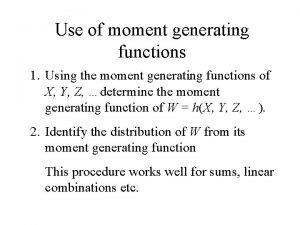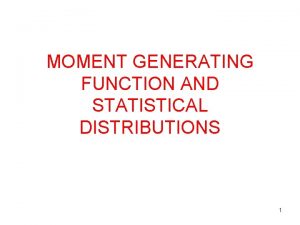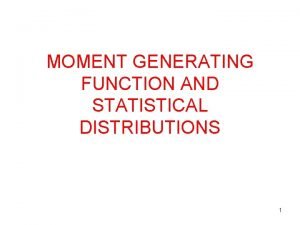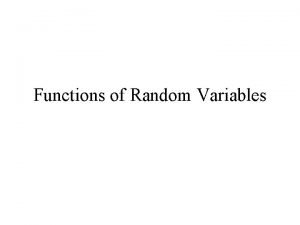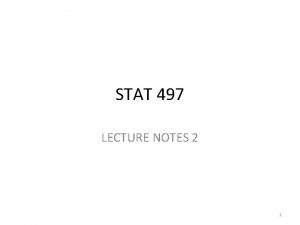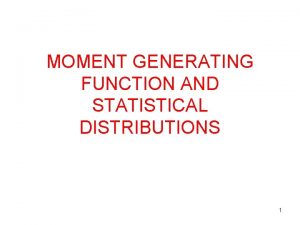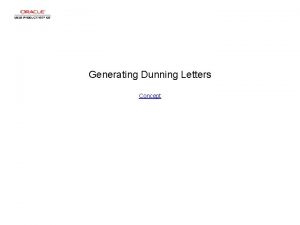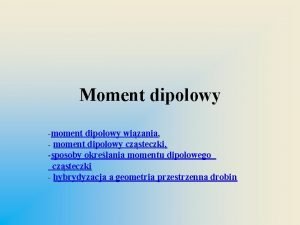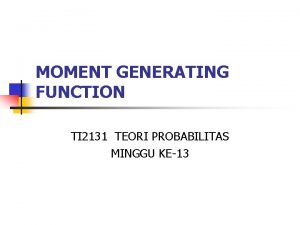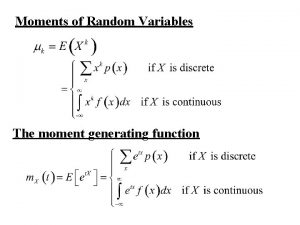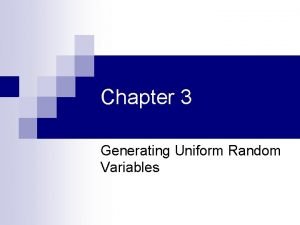The Moment Generating Function As A Useful Tool







































- Slides: 39

The Moment Generating Function As A Useful Tool in Understanding Random Effects on First-Order Environmental Dissipation Processes Dr. Bruce H. Stanley Du. Pont Crop Protection Stine-Haskell Research Center Newark, Delaware Del. Chapter of ASA Meeting: MGF and 1 st-Order Dissipation Slide 1 Bruce H. Stanley, Oct. 16, 2003

The Moment Generating Function As A Useful Tool in Understanding Random Effects on First. Order Environmental Dissipation Processes Abstract Many physical and, thus, environmental processes follow firstorder kinetics, where the rate of change of a substance is proportional to its concentration. The rate of change may be affected by a variety of factors, such as temperature or light intensity, that follow a probability distribution. The moment generating function provides a quick method to estimate the mean and variance of the process through time. This allows valuable insights for environmental risk assessment or process optimization. Del. Chapter of ASA Meeting: MGF and 1 st-Order Dissipation Slide 2 Bruce H. Stanley, Oct. 16, 2003

Agenda • First-order (FO) dissipation • The moment generating function (MGF) • Relationship between FO dissipation and MGF • Calculating the variance of dissipation • Other “curvilinear” models • Half-lives of the models • References • Conclusions Del. Chapter of ASA Meeting: MGF and 1 st-Order Dissipation Slide 3 Bruce H. Stanley, Oct. 16, 2003

- First-Order Dissipation - Del. Chapter of ASA Meeting: MGF and 1 st-Order Dissipation Slide 4 Bruce H. Stanley, Oct. 16, 2003

Model: First-Order Dissipation Rate of change: Model: Transformation to linearity: Constant half-life: Del. Chapter of ASA Meeting: MGF and 1 st-Order Dissipation Slide 5 Bruce H. Stanley, Oct. 16, 2003

Example: First-Order Dissipation Del. Chapter of ASA Meeting: MGF and 1 st-Order Dissipation Slide 6 Bruce H. Stanley, Oct. 16, 2003

Some Processes that Follow First-Order Kinetics • Radio-active decay • Population decline (i. e. , “death” processes) • Compounded interest/depreciation • Chemical decomposition • Etc… Del. Chapter of ASA Meeting: MGF and 1 st-Order Dissipation Slide 7 Bruce H. Stanley, Oct. 16, 2003

- The Moment Generating Function - Del. Chapter of ASA Meeting: MGF and 1 st-Order Dissipation Slide 8 Bruce H. Stanley, Oct. 16, 2003

Definition: Moment Generating Function Del. Chapter of ASA Meeting: MGF and 1 st-Order Dissipation Slide 9 Bruce H. Stanley, Oct. 16, 2003

Example: Moment Generating Function X ~ Gamma( , ) Del. Chapter of ASA Meeting: MGF and 1 st-Order Dissipation Slide 10 Bruce H. Stanley, Oct. 16, 2003

Relationship Between – First-Order Dissipation – and the Moment Generating Function Del. Chapter of ASA Meeting: MGF and 1 st-Order Dissipation Slide 11 Bruce H. Stanley, Oct. 16, 2003

Random First-Order Dissipation where r ~ PDF Constant Del. Chapter of ASA Meeting: MGF and 1 st-Order Dissipation Slide 12 Bruce H. Stanley, Oct. 16, 2003

Conceptual Model: Distribution of Dissipation Rates d. Ct 1/dt = r 1. Ct 1 d. Ct 2/dt = r 2. Ct 2 d. Ct 3/dt = r 3. Ct 3 d. Ct 4/dt = r 4. Ct 4 r<0 Del. Chapter of ASA Meeting: MGF and 1 st-Order Dissipation Slide 13 Bruce H. Stanley, Oct. 16, 2003

Transformation of r or t? r<0 X = -r It’s easier to transform t, I. e. , = -t so substitute t = - And treat r’s as positive when necessary r = -1. X fr(r) = f. X(-r) E(rn) = (-1)n. E(Xn) Del. Chapter of ASA Meeting: MGF and 1 st-Order Dissipation Slide 14 Bruce H. Stanley, Oct. 16, 2003

Typical Table of Distributions (Mood, Graybill & Boes. 1974. Intro. To the Theory of Stats. , 3 rd Ed. Mc. Graw-Hill. 564 pp. ) Del. Chapter of ASA Meeting: MGF and 1 st-Order Dissipation Slide 15 Bruce H. Stanley, Oct. 16, 2003

Some Possible Dissipation Rate Distributions • Uniform r ~ U(min, max) • Normal r ~ N( r, 2 r) • Lognormal r ~ LN( r= 2/2 + e , 2 r= r 2. (e 2 -1)) = ln[ r / (1+ r 2/ 2 r)], ; 2 = ln[1+ ( r 2/ 2 r)] • Gamma r ~ ( r= / , 2 r = / 2) = r 2/ 2 r; = r/ 2 r (distribution used in Gustafson and Holden 1990) * Where r and 2 r are the expected value and variance of the untransformed rates, respectively. Del. Chapter of ASA Meeting: MGF and 1 st-Order Dissipation Slide 16 Bruce H. Stanley, Oct. 16, 2003

Application to Dissipation Model: Uniform No need to make = -t substitution Del. Chapter of ASA Meeting: MGF and 1 st-Order Dissipation Slide 17 Bruce H. Stanley, Oct. 16, 2003

Application to Dissipation Model: Normal No need to make = -t substitution Note: Begins increasing at t = - r/ r 2, and becomes >C 0 after t = -2. r/ r 2. Del. Chapter of ASA Meeting: MGF and 1 st-Order Dissipation Slide 18 Bruce H. Stanley, Oct. 16, 2003

Application to Dissipation Model: Lognormal Note: Same as normal on the log scale. Del. Chapter of ASA Meeting: MGF and 1 st-Order Dissipation Slide 19 Bruce H. Stanley, Oct. 16, 2003

Application to Dissipation Model: Gamma (Gustafson and Holden (1990) Model) Make = -t substitution Del. Chapter of ASA Meeting: MGF and 1 st-Order Dissipation Slide 20 Bruce H. Stanley, Oct. 16, 2003

Distributed Loss Model Del. Chapter of ASA Meeting: MGF and 1 st-Order Dissipation Slide 21 Bruce H. Stanley, Oct. 16, 2003

Key Paper: Gustafson & Holden (1990) Del. Chapter of ASA Meeting: MGF and 1 st-Order Dissipation Slide 22 Bruce H. Stanley, Oct. 16, 2003

- Calculating the Variance - Del. Chapter of ASA Meeting: MGF and 1 st-Order Dissipation Slide 23 Bruce H. Stanley, Oct. 16, 2003

Example: Variance for the Gamma Case Make = -t substitution Del. Chapter of ASA Meeting: MGF and 1 st-Order Dissipation Slide 24 Bruce H. Stanley, Oct. 16, 2003

- Random Initial Concentration - Del. Chapter of ASA Meeting: MGF and 1 st-Order Dissipation Slide 25 Bruce H. Stanley, Oct. 16, 2003

Variable Initial Concentration: Product of Random Variables Delta Method Del. Chapter of ASA Meeting: MGF and 1 st-Order Dissipation Slide 26 Bruce H. Stanley, Oct. 16, 2003

- Other “Non-Linear” Models - Del. Chapter of ASA Meeting: MGF and 1 st-Order Dissipation Slide 27 Bruce H. Stanley, Oct. 16, 2003

Other “Non-linear” Models • Bi- (or multi-) first-order model ………. . . • Non-linear functions of time, …………. . …… e. g. , t = degree days or cum. rainfall (Nigg et al. 1977) • First-order with asymptote (Pree et al. 1976). . • Two-compartment first-order………………. . • Distributed loss rate…………. …… (Gustafson and Holden 1990) • Power-rate model (Hamaker 1972)………. . … Del. Chapter of ASA Meeting: MGF and 1 st-Order Dissipation Slide 28 Bruce H. Stanley, Oct. 16, 2003

First-order With Asymptote Del. Chapter of ASA Meeting: MGF and 1 st-Order Dissipation Slide 29 Bruce H. Stanley, Oct. 16, 2003

Two Compartment Model Del. Chapter of ASA Meeting: MGF and 1 st-Order Dissipation Slide 30 Bruce H. Stanley, Oct. 16, 2003

Distributed Loss Model Del. Chapter of ASA Meeting: MGF and 1 st-Order Dissipation Slide 31 Bruce H. Stanley, Oct. 16, 2003

Power Rate Model Del. Chapter of ASA Meeting: MGF and 1 st-Order Dissipation Slide 32 Bruce H. Stanley, Oct. 16, 2003

- Half-lives - Del. Chapter of ASA Meeting: MGF and 1 st-Order Dissipation Slide 33 Bruce H. Stanley, Oct. 16, 2003

Half-lives for Various Models (p = 0. 5) • First-order*……………. • Multi-first-order*………………… • First-order with asymptote ……… • Two-compartment first-order …… • Distributed loss rate ……………. . • Power-rate model ………………. * Can substitute cumulative environmental factor for time, i. e. , Del. Chapter of ASA Meeting: MGF and 1 st-Order Dissipation Slide 34 Bruce H. Stanley, Oct. 16, 2003

- References - Del. Chapter of ASA Meeting: MGF and 1 st-Order Dissipation Slide 35 Bruce H. Stanley, Oct. 16, 2003

References Duffy, M. J. , M. K. Hanafey, D. M. Linn, M. H. Russell and C. J. Peter. 1987. Predicting sulfonylurea herbicide behavior under field conditions Proc. Brit. Crop Prot. Conf. – Weeds. 2: 541 -547. [Application of 2 -compartment first-order model] Gustafson, D. I. And L. R. Holden. 1990. Nonlinear pesticide dissipation in Soil: a new model based upon spatial variability. Environ. Sci. Technol. 24 (7): 1032 -1038. [Distributed rate model] Hamaker, J. W. 1972. Decomposition: quantitative aspects. Pp. 253 -340 In C. A. I. Goring and J. W. Hamaker (eds. ) Organic Chemicals in the Soil Environment, Vol 1. Marcel Dekker, Inc. , NY. [Power rate model] Nigg, H. N. , J. C. Allen, R. F. Brooks, G. J. Edwards, N. P. Thompson, R. W. King and A. H. Blagg. 1977. Dislodgeable residues of ethion in Florida citrus and relationships to weather variables. Arch. Environ. Contam. Toxicol. 6: 257 -267. [First-order model with cumulative environmental variables] Pree, D. J. , K. P. Butler, E. R. Kimball and D. K. R. Stewart. 1976. Persistence of foliar residues of dimethoate and azinphosmethyl and their toxicity to the apple maggot. J. Econ. Entomol. 69: 473 -478. [First-order model with non-zero asymptote] Del. Chapter of ASA Meeting: MGF and 1 st-Order Dissipation Slide 36 Bruce H. Stanley, Oct. 16, 2003

Conclusions • Moment-generating function is a quick way to predict the effects of variability on dissipation • Variability in dissipation rates can lead to “nonlinear” (on log scale) dissipation curves • Half-lives are not constant when variability is present • A number of realistic mechanisms can lead to a curvilinear dissipation curve (i. e. , model is not “diagnostic”) Del. Chapter of ASA Meeting: MGF and 1 st-Order Dissipation Slide 37 Bruce H. Stanley, Oct. 16, 2003

Questions? Del. Chapter of ASA Meeting: MGF and 1 st-Order Dissipation Slide 38 Bruce H. Stanley, Oct. 16, 2003

- Thank You! Del. Chapter of ASA Meeting: MGF and 1 st-Order Dissipation Slide 39 Bruce H. Stanley, Oct. 16, 2003
 Moment generating function for normal distribution
Moment generating function for normal distribution Moment generating function bernoulli
Moment generating function bernoulli Multinomial distribution pdf
Multinomial distribution pdf Moment generating function of normal distribution
Moment generating function of normal distribution Moment of a random variable
Moment of a random variable Moment generating function of binomial distribution
Moment generating function of binomial distribution Autocovariance generating function
Autocovariance generating function What characteristics make hair a useful forensics tool?
What characteristics make hair a useful forensics tool? The offset tool is useful in setting up an auxiliary view
The offset tool is useful in setting up an auxiliary view What is the purpose of an auxiliary view
What is the purpose of an auxiliary view Section 8-3 guidelines for healthful eating
Section 8-3 guidelines for healthful eating Lesson 3: guidelines for eating
Lesson 3: guidelines for eating Potter's tool is data cleaning tool
Potter's tool is data cleaning tool Hình ảnh bộ gõ cơ thể búng tay
Hình ảnh bộ gõ cơ thể búng tay Frameset trong html5
Frameset trong html5 Bổ thể
Bổ thể Tỉ lệ cơ thể trẻ em
Tỉ lệ cơ thể trẻ em Chó sói
Chó sói Tư thế worm breton là gì
Tư thế worm breton là gì Chúa yêu trần thế alleluia
Chúa yêu trần thế alleluia Các môn thể thao bắt đầu bằng tiếng nhảy
Các môn thể thao bắt đầu bằng tiếng nhảy Thế nào là hệ số cao nhất
Thế nào là hệ số cao nhất Các châu lục và đại dương trên thế giới
Các châu lục và đại dương trên thế giới Công thức tiính động năng
Công thức tiính động năng Trời xanh đây là của chúng ta thể thơ
Trời xanh đây là của chúng ta thể thơ Cách giải mật thư tọa độ
Cách giải mật thư tọa độ Làm thế nào để 102-1=99
Làm thế nào để 102-1=99 Phản ứng thế ankan
Phản ứng thế ankan Các châu lục và đại dương trên thế giới
Các châu lục và đại dương trên thế giới Thể thơ truyền thống
Thể thơ truyền thống Quá trình desamine hóa có thể tạo ra
Quá trình desamine hóa có thể tạo ra Một số thể thơ truyền thống
Một số thể thơ truyền thống Cái miệng nó xinh thế chỉ nói điều hay thôi
Cái miệng nó xinh thế chỉ nói điều hay thôi Vẽ hình chiếu vuông góc của vật thể sau
Vẽ hình chiếu vuông góc của vật thể sau Biện pháp chống mỏi cơ
Biện pháp chống mỏi cơ đặc điểm cơ thể của người tối cổ
đặc điểm cơ thể của người tối cổ Giọng cùng tên là
Giọng cùng tên là Vẽ hình chiếu đứng bằng cạnh của vật thể
Vẽ hình chiếu đứng bằng cạnh của vật thể Vẽ hình chiếu vuông góc của vật thể sau
Vẽ hình chiếu vuông góc của vật thể sau Thẻ vin
Thẻ vin
